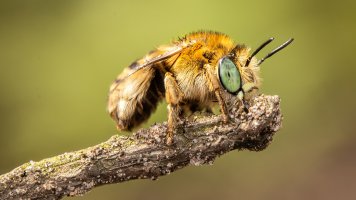
I am almost always holding on to whatever the critter is perched on with my non camera hand, and then resting the lens on that same hand so that subject and camera are on the same "platform". I focus by sliding the lens on my hand, and can rotate the subject's perch to change the angle of it and/or get it looking into the camera. I will then pick a spot where I want the area of acceptable focus to start, like this Swallowtail Butterfly's proboscis, and then twist my wrist (the one holding the camera) to lay the area of acceptable focus over the critter's leading eye trying to get as much of its face in focus.
 Swallowtail Portrait
Swallowtail Portrait by
John Kimbler, on Flickr
I call it the Left Hand Brace Technique and using it gives me a lot of control over where I am placing the area of acceptable focus. An angle that creates the illusion that there is a lot of depth of field is called a "magic angle" and when I first got into macro 15 years ago I would look for them. But now I create those magic angles with the way that I position the subject relative to the sensor. According to the manual for Canon's MP-E 65mm macro lens the depth of field for this next shot is less than half a millimeter -or less than half the thickness of a US dime for the metric impaired

 Resin Bee
Resin Bee by
John Kimbler, on Flickr
We are wired to look into the eyes of the animals that we encounter in order to gauge intent, and the eyes are the very first thing we look at. So the leading eye, or both eyes if the subject is looking directly into the camera, have to be in focus. If they are not then the entire image will be perceived as out of focus. Likewise if the eyes are in focus then the image is perceived as being in focus, so it is not necessary to get the entire subject in focus.
Also we use shadows and out of focus areas to gauge depth. Get everything in focus, and evenly lit (to avoid stacking artifacts), and the scene will look flat and that is one of the big reasons why I do not focus stack. I want to create images where it looks like the subject is popping out of the frame. My goal is not to make my photos look natural, but to keep them from looking unnatural because the suspension of disbelief also applies to still images. I want the viewer to be able to relax and just enjoy what I put in front of them, and scenes that look flat seem odd and out of place because that is not how we see the world around us.
Edit: Wanted to add that no one crops their images when they view them at 100% pixels and then prints those crops, or saves them to any device as wallpaper. Everyone who is looking for an image to print, or for wallpaper, is looking at photos edge to edge. So absolute image sharpness is a false metric and has nothing to do with image quality. But per pixel sharpness is an easy metric, there are formulas for diffraction but none for creativity, so a lot of photographers resort to focus stacking. Stacking comes with so many limitations that I would argue that it can keep a photographer from developing their creative side.



